You need to design an analytical storage solution for the transactional data. The solution must meet the sales transaction dataset requirements.
What should you include in the solution? To answer, select the appropriate options in the answer area.
NOTE: Each correct selection is worth one point.
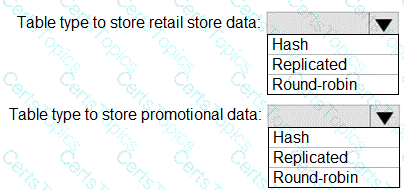
You need to implement the surrogate key for the retail store table. The solution must meet the sales transaction dataset requirements.
What should you create?
You need to design a data retention solution for the Twitter feed data records. The solution must meet the customer sentiment analytics requirements.
Which Azure Storage functionality should you include in the solution?
You need to recommend a backup solution to restore DB3. The solution must meet the availability requirements. Which type of backup should you use?
You plan to deploy Instance1 by using the following script.
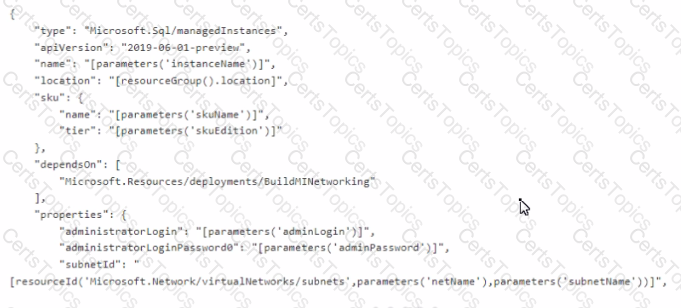
You need to specify the licenseType and storagenedundancy parameters. The deployment must meet the availability requirements and the business requirements for DB1 and DB2.
To what should you set each parameter? To answer, select the appropriate options in the answer area.
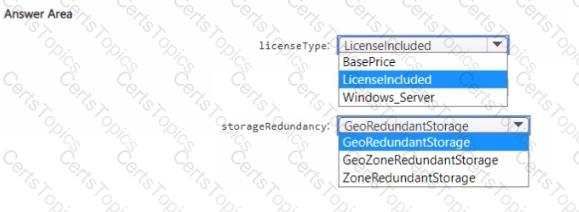
You need to recommend a solution to meet the security requirements and the business requirements for DB3. What should you recommend as the first step of the solution?
You need to identify the event_file target for monitonng DB3 after the migration to Azure SQL Database. The solution must meet the management requirements.
What should you use as the event_file target?
You need to recommend which configuration to perform twice to enable access to the primary and secondary replicas of DB3. The solution must meet the availability requirements.
What should you recommend?
You need to identify the event_flle target for monitonng DB3 after the migration to Azure SQL Database. The solution must meet the management requirements,
What should you use as the event_file target?
You need to recommend a solution to ensure that the performance of DB3 is optimized after the migration to Azure SQL Database. The solution must meet availability requirements.
What should you include in the recommendation?
You need to recommend which service and target endpoint to use when migrating the databases from SVR1 to Instance1. The solution must meet the availability requirements.
What should you recommend? To answer, select the appropriate options in the answer area.
NOTE Each correct selection is worth one point.
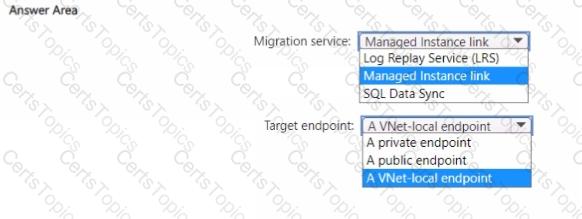
You need to recommend a process to automate the management of DB3. The solution must meet the management requirements. What should be the first step of the process?
You need to recommend a solution that will enable remote developers to access DB1 and DB2. The solution must support the planned changes and meet the secunty requirements.
What should you include in the recommendation?
You need to recommend a service tier and a method to offload analytical workloads for the databases migrated from SVR1. The solution must meet the availability and business requirements.
What should you recommend? To answer, select the appropriate options in the answer area.
NOTE: Each correct selection is worth one point.
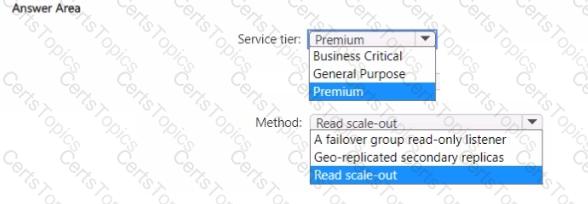
Which counter should you monitor for real-time processing to meet the technical requirements?
You need to recommend an authentication solution for App1 access to DB1 and DB2 after their migration to Instance1. The solution must meet the availability requirements.
Which actions should you perform in sequence? To answer, drag the appropriate actions to the correct order. Each action may be used once, more than once, or not at all. You may need to drag the split bar between panes or scroll to view content.
NOTE: Each correct selection is worth one point.

Which windowing function should you use to perform the streaming aggregation of the sales data?
You need to identify the cause of the performance issues on SalesSQLDb1.
Which two dynamic management views should you use? Each correct answer presents part of the solution.
NOTE: Each correct selection is worth one point.
You need to recommend the appropriate purchasing model and deployment option for the 30 new databases. The solution must meet the technical requirements and the business requirements.
What should you recommend? To answer, select the appropriate options in the answer area.
NOTE: Each correct selection is worth one point.
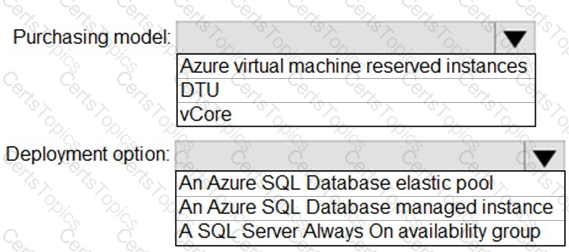
You need to configure user authentication for the SERVER1 databases. The solution must meet the security and compliance requirements.
Which three actions should you perform in sequence? To answer, move the appropriate actions from the list of actions to the answer area and arrange them in the correct order.
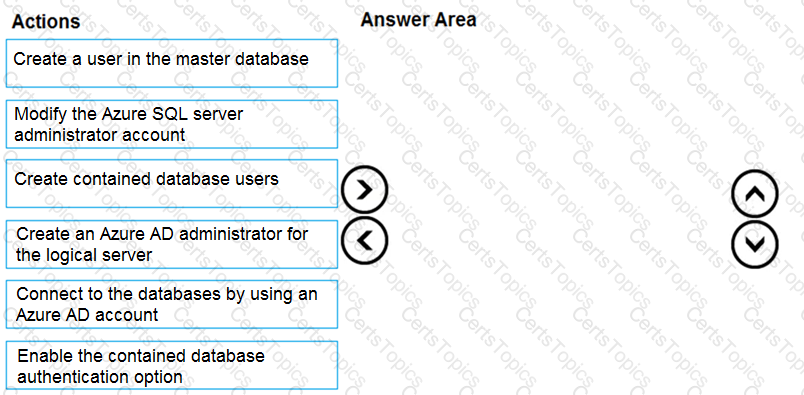
What should you do after a failover of SalesSQLDb1 to ensure that the database remains accessible to SalesSQLDb1App1?
You are evaluating the business goals.
Which feature should you use to provide customers with the required level of access based on their service agreement?
You create all of the tables and views for ResearchDB1.
You need to implement security for ResearchDB1. The solution must meet the security and compliance requirements.
Which three actions should you perform in sequence? To answer, move the appropriate actions from the list of actions to the answer area and arrange them in the correct order.
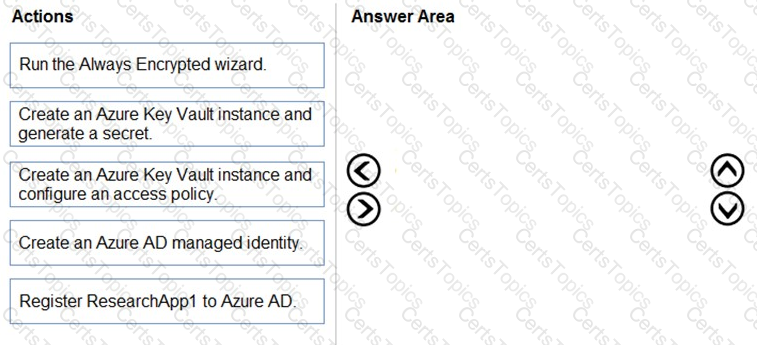
You need to implement the monitoring of SalesSQLDb1. The solution must meet the technical requirements.
How should you collect and stream metrics? To answer, select the appropriate options in the answer area.
NOTE: Each correct selection is worth one point.
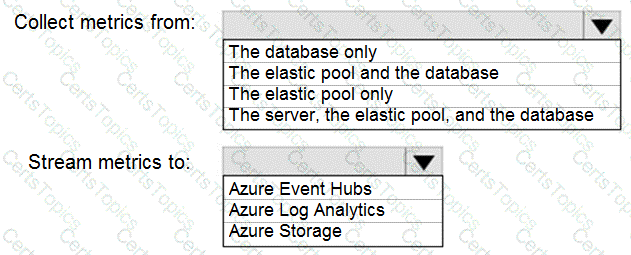
You need to recommend a configuration for ManufacturingSQLDb1 after the migration to Azure. The solution must meet the business requirements.
What should you include in the recommendation? To answer, select the appropriate options in the answer area.
NOTE: Each correct selection is worth one point.
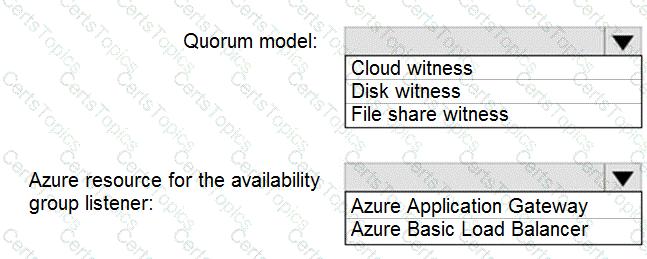
You need to recommend a solution to ensure that the customers can create the database objects. The solution must meet the business goals.
What should you include in the recommendation?
You are planning the migration of the SERVER1 databases. The solution must meet the business requirements.
What should you include in the migration plan? To answer, select the appropriate options in the answer area.
NOTE: Each correct selection is worth one point.

You need to implement authentication for ResearchDB1. The solution must meet the security and compliance requirements.
What should you run as part of the implementation?
You need to provide an implementation plan to configure data retention for ResearchDB1. The solution must meet the security and compliance requirements.
What should you include in the plan?
You need to implement statistics maintenance for SalesSQLDb1. The solution must meet the technical requirements.
Which four actions should you perform in sequence? To answer, move the appropriate actions from the list of actions to the answer area and arrange them in the correct order.
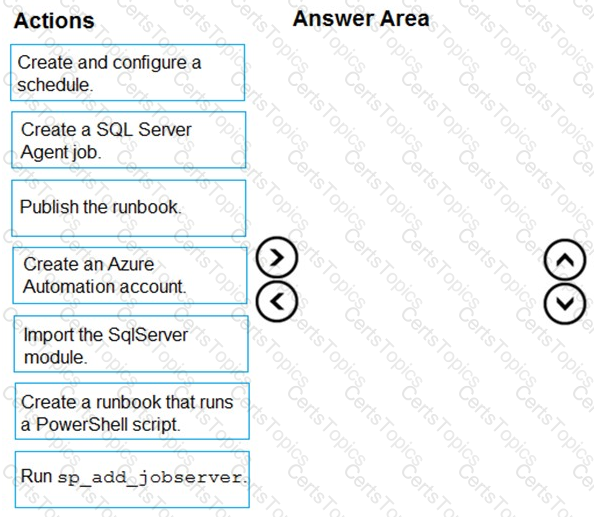
You have an Azure subscription.
You need to deploy a new Azure SQL database by using Azure Command-Line Interface (CLI).
Which three parameters are required?
A)

B)

C)

D)

You have SQL Server on an Azure virtual machine that contains a database named Db1.
You need to enable automatic tuning for Db1.
How should you complete the statements? To answer, select the appropriate answer in the answer area.
NOTE: Each correct selection is worth one point.
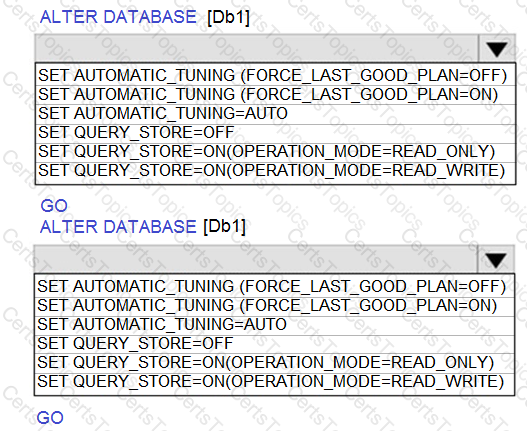
You have an Azure AD tenant and a logical Microsoft SQL server named SQL1 that hosts several Azure SQL databases.
You plan to assign Azure AD users permissions to the databases automatically by using Azure Automation.
You need to create the required Automation accounts.
Which two accounts should you create? Each correct answer presents part of the solution.
NOTE: Each correct selection is worth one point.
You have an Azure SQL database named db1 on a server named server1.
You need to modify the MAXDOP settings for db1.
What should you do?
Task 1
In an Azure SQL database named db1, you need to enable page compression on the PK_SalesOrderHeader_SalesOrderlD clustered index of the SalesLT.SalesOrderHeader table.
Task 11
You have a legacy application written for Microsoft SQL Server 2012. The application will be the only application that accesses db1 You need to ensure that db1 is compatible with all the features and syntax of SQL Server 2012.
Task 4
You need to enable change data capture (CDC) for db1.
Task 7
You plan to create an automation runbook that will create database users in db1 from Azure AD identities. You need to configure sq1370O6895 to support the creation of new database users.
Task 3
You need to ensure that all queries executed against dbl are captured in the Query Store.
Task 6
You need to ensure that any enhancements made to the Query Optimizer through patches are available to dbl and db2 on sql37006895.
Task 9
You need to generate an email alert to admin@contoso.com when CPU percentage utilization for db1 is higher than average.
Task 8
You plan to perform performance testing of db1.
You need prevent db1 from reverting to the last known good query plan.
Task 5
You need to configure a disaster recovery solution for db1. When a failover occurs, the connection strings to the database must remain the same. The secondary server must be in the West US 3 Azure region.
Task 2
You need to configure your user account as the Azure AD admin for the server named sql3700689S.
Task 12
You need to configure high availability for dbl. The solution must tolerate the loss of an Azure datacenter without data loss or the need to modify application connection strings.
Task 10
You need to protect all the databases on sql37006S95 from SQL injection attacks.
Based on the PaaS prototype, which Azure SQL Database compute tier should you use?
You need to implement a solution to notify the administrators. The solution must meet the monitoring requirements.
What should you do?
What should you use to migrate the PostgreSQL database?
You are evaluating the role assignments.
For each of the following statements, select Yes if the statement is true. Otherwise, select No.
NOTE: Each correct selection is worth one point.
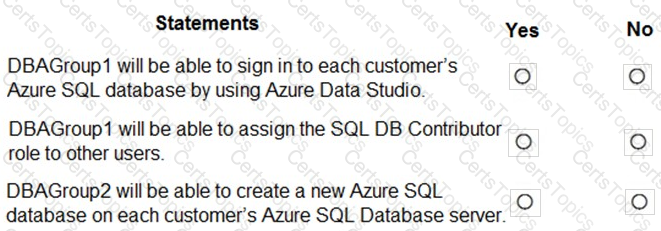
What should you implement to meet the disaster recovery requirements for the PaaS solution?